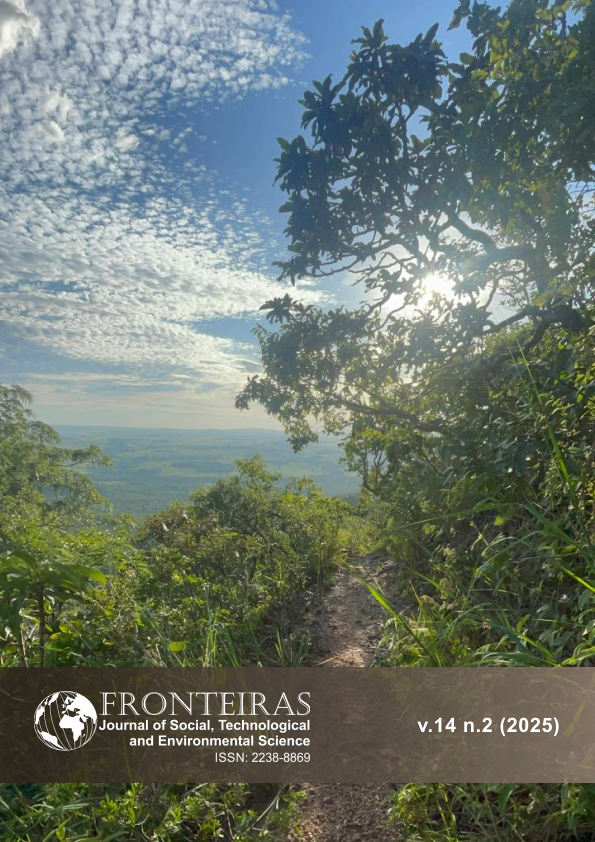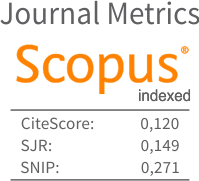Caracterização da Composição Química dos Sedimentos e a Presença de Coliformes Termotolerantes em Diferentes Sub-Bacias Hidrográficas do Rio Grande
DOI:
https://doi.org/10.21664/2238-8869.2025v14i2.p315-329Palabras clave:
nascente, sedimento, metais tóxicos, uso e ocupação do soloResumen
A água e os sedimentos em nascentes são influenciados por fatores naturais e antrópicos. Em áreas rurais, a atividade agropecuária exerce influência na dinâmica e estrutura dos ecossistemas de nascentes. Este estudo teve como objetivo verificar diferenças na composição química dos sedimentos e na presença de coliformes termotolerantes na água de 15 nascentes da região da Serrinha, localizadas em paisagem rural de cinco sub-bacias do Rio Grande, no Cerrado Mineiro. Foram analisadas concentrações de metais e nutrientes, além da estimativa da densidade de coliformes termotolerantes, a fim de correlacionar esses parâmetros com o uso e ocupação da terra. Os elementos chumbo, cromo, níquel e manganês não foram detectados nas amostras, dentro dos limites do equipamento utilizado. A análise de componentes principais (ACP) indicou que a sub-bacia 3 apresentou maiores concentrações de cálcio, enquanto a sub-bacia 6 se destacou pelo teor elevado de fósforo, alumínio e magnésio. A sub-bacia 2 apresentou altos níveis de potássio e ferro, enquanto as sub-bacias 1 e 4 mostraram as maiores concentrações de cobre e coliformes termotolerantes, possivelmente associadas à presença de áreas de pastagem próximas. Os valores de coliformes nestas sub-bacias sugerem influência direta da atividade pecuária, reforçando a necessidade de práticas de manejo que impeçam o contato de dejetos animais com a água das nascentes. Os resultados indicam que a dinâmica dos elementos químicos nos sedimentos está diretamente relacionada ao uso da terra na região. Esses achados reforçam a importância da preservação adequada da vegetação ciliar e do controle da poluição difusa para garantir a qualidade dos recursos hídricos.
Citas
Alvares CA, Stape JL, Sentelhas PC, Gonçalves JLM, Sparovek G 2023. Köppen's climate classification map for Brazil. Meteorologische Zeitschrift 22(6):711-728.
Alves RIS, Sampaio CF, Nadal M, Schuhmacher M, Domingo JL, Segura-Muños SI 2014. Metal concentrations in surface water and sediments from Pardo River, Brazil: human health risks. Environmental Research 133:149-155.
Anyanwu ED, Onyele OG 2018. Occurrence and concentration of heavy metals in a rural spring in South-Eastern Nigeria. Journal of Applied Sciences and Environmental Management 22:1473–1478.
Botrel N, Freitas S, Fonseca MJO, Melo RAC, Madeira N 2020. Valor nutricional de hortaliças folhosas não convencionais cultivadas no Bioma Cerrado. Brazilian Journal of Food Technology 23:e2018174.
Brasil. Conselho Nacional de Meio Ambiente - CONAMA. Resolução nº 357, de 17 de março de 2005. Dispõe sobre a classificação das águas doces, salinas e salobras do território nacional e estabelece as condições e padrões de lançamento de efluentes. Diário Oficial da União, 17 de março de 2005.
Brasil. Lei no 12.651, de 25 de maio de 2012. Dispõe sobre a proteção da vegetação nativa; altera as Leis no 6.938, de 31 de agosto de 1981, 9.393, de 19 de dezembro de 1996, e 11.428, de 22 de dezembro de 2006; revoga as Leis no 4.771, de 15 de setembro de 1965, e 7.754, de 14 de abril de 1989, e a Medida Provisória no 2.166-67, de 24 de agosto de 2001; e dá outras providências. Disponível em: http://www.planalto.gov.br/ccivil_03/_ato2011-2014/2012/lei/L12651compilado.htm. Acesso em: 03 mai 2024.
Brasil. Ministério do Meio Ambiente (MMA). Águas subterrâneas: um recurso a ser conhecido e protegido. Secretaria de Recursos Hídricos e Ambiente Urbano. Brasília, DF: MMA, 2007.
Brito LM, Santos ECL, Silva ALS, López AMQ, Silva ACC, Melo JG 2024. Qualidade físico-química e microbiológica da água de nascentes da bacia hidrográfica do Rio Coruripe, Alagoas-Brasil. Interfaces Científicas – Saúde e Ambiente 9(3):53-67.
Carvalho EMD, Uieda VS 2004. Colonização por macroinvertebrados bentônicos em substrato artificial e natural em um riacho da serra de Itatinga, São Paulo, Brasil. Revista Brasileira de Zoologia 21:287-293.
Cloud Software Group, INC. Statistica. Data Science Workbench, version 14. 2023 http://tibco.com.
CPRM - COMPANHIA DE PESQUISA DE RECURSOS MINERAIS. Projeto Rede Integrada de Monitoramento das Águas Subterrâneas: relatório diagnóstico Sistema Aquífero Bauru–Caiuá no Estado de Minas Gerais. Belo Horizonte/MG, CPRM – Serviço Geológico do Brasil. 2012.
Souza CLF, Oliveira RB, Mustafé DN, Nunes KAC, Morais EMB 2019. O cerrado como o “berço das águas”: potencialidades para a educação geográfica. Revista Cerrados (Unimontes) 17(1):86-113.
Embrapa. Manual de Métodos de Análise de Solo. 3. ed. Brasília: Embrapa, 2017.
Felfili JM, Sousa-Silva JC, Scariot A 2005. Biodiversidade, ecologia e conservação do cerrado: avanços no conhecimento. In Scariot A., Sousa-Silva JC, Felfili JM. Cerrado: ecologia, biodiversidade e conservação. Ministério do Meio Ambiente, Brasília. p. 61-72.
Garcia CAB, Santos MS, Bellin IC, Santos EAO, Costa SSL, Garcia HL 2022. Determinação de metais em alimentos vegetais produzidos nos perímetros irrigados Jacarecica I e Açude Macela em Sergipe. Research, Society and Development 11(16):e559111638736.
Haridasan M 2008. Nutritional adaptations of native plants of the cerrado biome in acid soils. Journal of Plant Physiology 20(3): 183-195.
IBGE – INSTITUTO BRASILEIRO DE GEOGRAFIA E ESTATÍSTICA. IBGE Cidades: Frutal. 2023. Disponível em: https://cidades.ibge.gov.br/brasil/mg/frutal/pesquisa/14/10193?ano=2022. Acesso em: 27 nov. 2023.
IDEXX. Laboratories, Inc., One IDEXX Drive, Westbrook, Maine 04092 USA idexx.com/water. 2017. Disponível em: https://www.idexx.es/files/colilert-procedure-en.pdf.
Legendre P, Legendre L. Numerical ecology. 3. Ed, Amsterdam, Elsevier Science, 2012.
MAPBIOMAS. Projeto MapBiomas – Coleção 3.1 da Série Anual de Mapas de Cobertura e Uso da Terra no Brasil.
Medeiro MLS, Demartelaere ACF, Pereira MD, Pádua GVG 2019. Adequação do teste de lixiviação de potássio em sementes de Moringa oleifera. Ciência Florestal 29(2):941-949.
Mehlich A. Determination of P, Ca, Mg, K, Na and NH4. Raleigh, North Carolina Soil Testing Division, 1953. 195 p.
Moraes RA 2020. Análise das mudanças do uso e da cobertura da terra em municípios com áreas de mineração na microrregião de Itabira, a partir de dados do MAPBIOMAS entre 1987 e 2017. Revista Engenharia de Interesse Social 5(6):77-96.
Moreira EA, Souza TS, Domingo SS, Siqueira APS 2019. Protocolo de recuperação de nascentes no bioma cerrado. Informe Goiano 7(4): 1-4.
Moreira GN, Biscalquini AC, Gonçalves IAV, Silva ER, Senhuk APMS, Anhê ACBM 2024. Uso de macroinvertebrados bentônicos para análise integrada da sub-bacia do Ribeirão Conquitinha, afluente do Rio Grande (MG, Brasil). Scientia Plena 20(2):022401.
Nascimento DTF, Novais GT 2020. Clima do Cerrado: dinâmica atmosférica e características, variabilidades e tipologias climáticas. Élisée - Revista de Geografia da UEG 9(2):922021.
Nascimento DBD, Lopes MLS, Izidro JLPS, Bezerra RCA, Gois GC, Amaral TNE, Dias WS, Barros MML, Oliveira ARS, Farias-Sobrinho JL, Coêlho JJ 2024. Ciclagem de nitrogênio, fósforo e potássio em ecossistemas de pastagem. Ciência Animal Brasileira, 25:e-76743.
Novais GT 2019. Classificação climática aplicada ao Bioma Cerrado. Tese de Doutorado, Universidade Federal de Uberlândia, Instituto de Geografia, 184pp.
Owens P 2008. Sediment Management at the River Basin Scale. In: Sustainable Management of Sediment Resources. Vol. 4, Elsevier Science, UK, 280 pp.
Paula-Filho FJ, Marins RV, Lacerda LD, Aguiar JE, Peres TF 2015. Background values for evaluation of heavy metal contamination in sediments in the Parnaíba River Delta estuary, NE/Brazil. Marine Pollution Bulletin, 91:424-428.
Pinto MN, Lira RA, Meira-Neto JÁ 2020. Ecologia funcional: Relação do gradiente pedológico e abundância de espécies lenhosas do Cerrado Brasileiro. Biota Amazônia 10(1):6-10.
Reis LBS, Mesquita MN, De-Carvalho PS, Miranda SC 2022. Atributos funcionais de espécies vegetais do Cerrado–importância, aspectos metodológicos e ecológicos. Enciclopédia Biosfera 19(40):76-92.
Santos EO, Schwantz PI, Bohrer REG, Prestes MMB, Lara DM, 2021. Análise ambiental de nascentes do bairro Fontes no município de Soledade (RS), Brasil. Revista em Agronegócio e Meio Ambiente 14:2e8771.
Silva SC, Medeiros LS, Neto, MFB, Silva MJ, Ramos, TPA, Lima FCT, Lima SMQ 2023. Ichthyofauna of the Nascentes do Rio Parnaíba National Park: watershed divide in the main agricultural encroachment area in the Brazilian Cerrado. Biota Neotropica 23(1):e20221414.
Descargas
Publicado
Cómo citar
Número
Sección
Licencia
Derechos de autor 2025 Lelisberto Baldo Vieira, Eliana Aparecida Panarelli, Daniela Fernanda da Silva Fuzzo, Rodrigo Ney Millan

Esta obra está bajo una licencia internacional Creative Commons Atribución-NoComercial 4.0.
Esta revista oferece acesso livre imediato ao seu conteúdo, seguindo o princípio de que disponibilizar gratuitamente o conhecimento científico ao público proporciona maior democratização mundial do conhecimento.
A partir da publicação realizada na revista os autores possuem copyright e direitos de publicação de seus artigos sem restrições.
A Revista Fronteiras: Journal of Social, Technological and Environmental Science segue os preceitos legais da licença Creative Commons - Atribuição-NãoComercial 4.0 Internacional.


